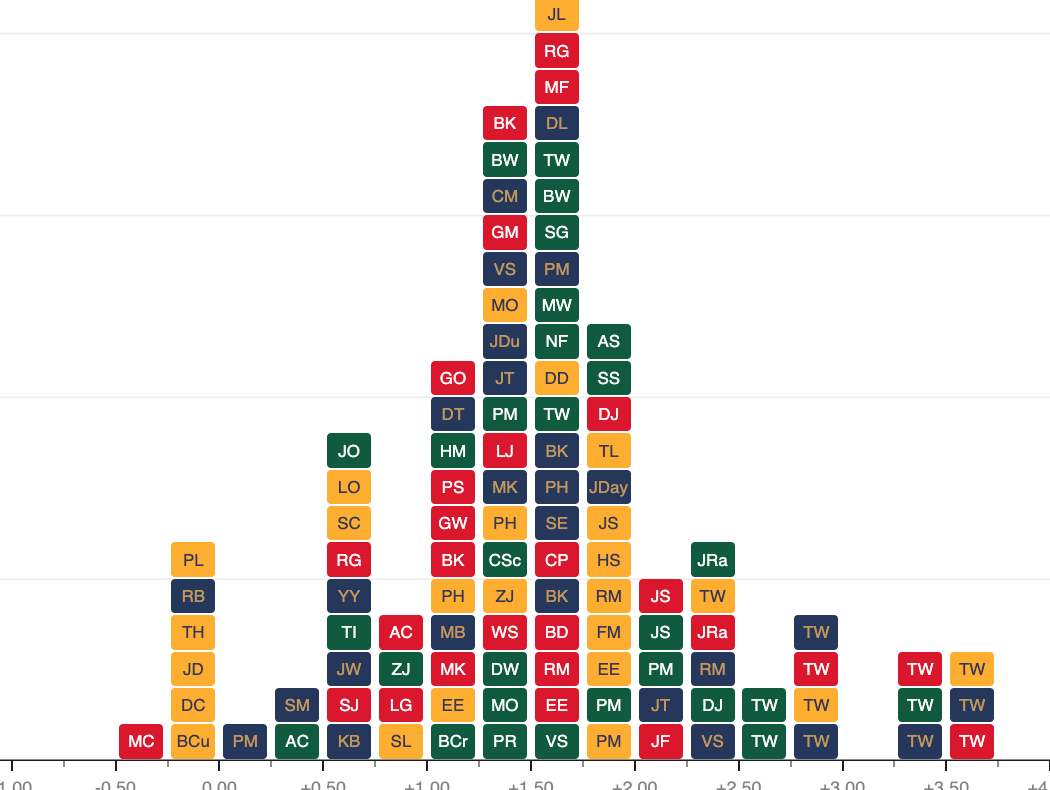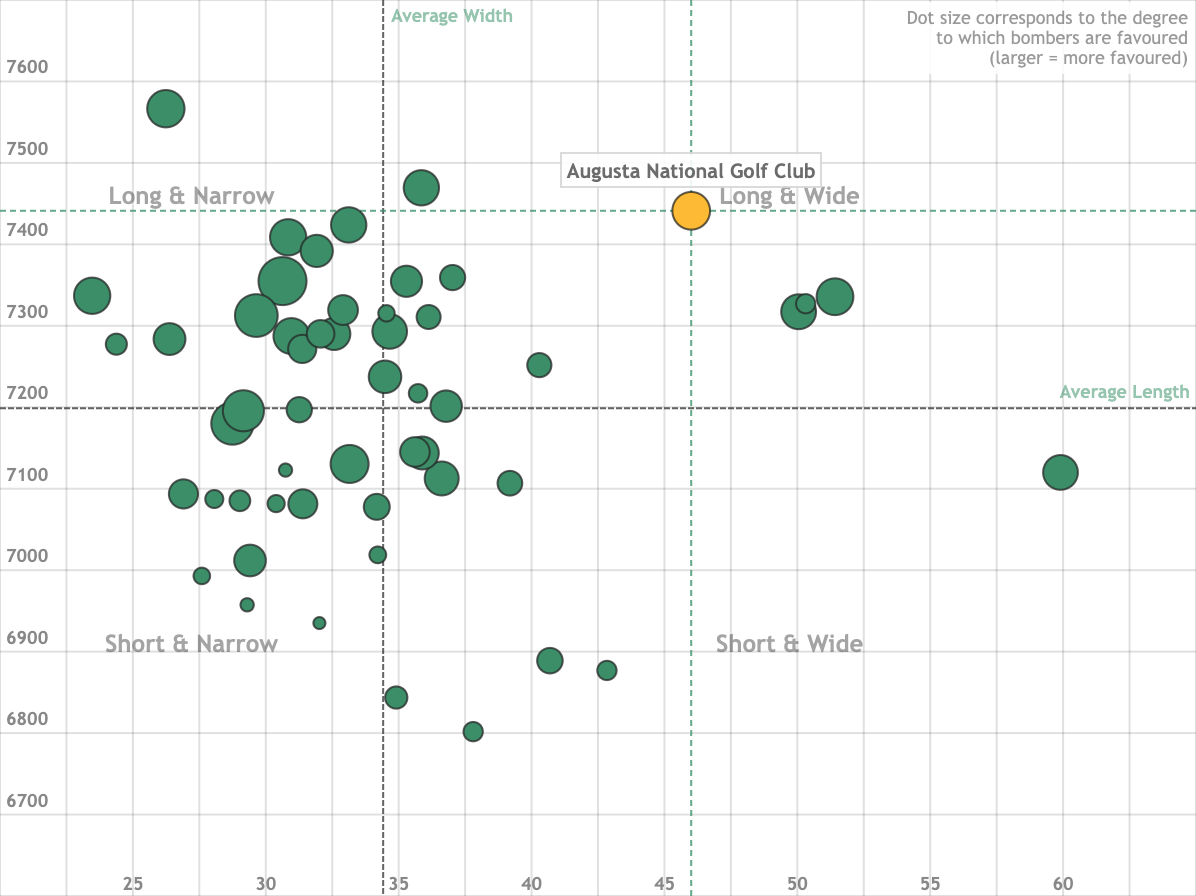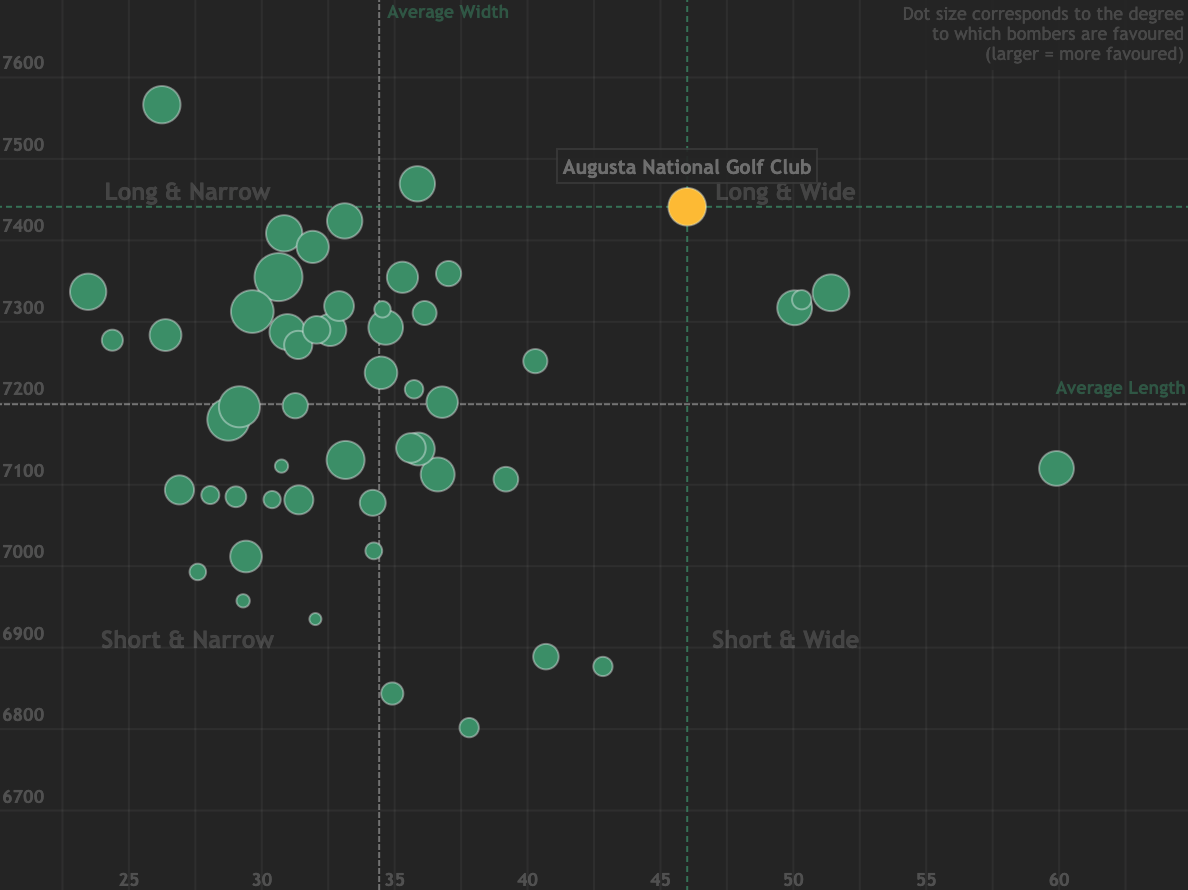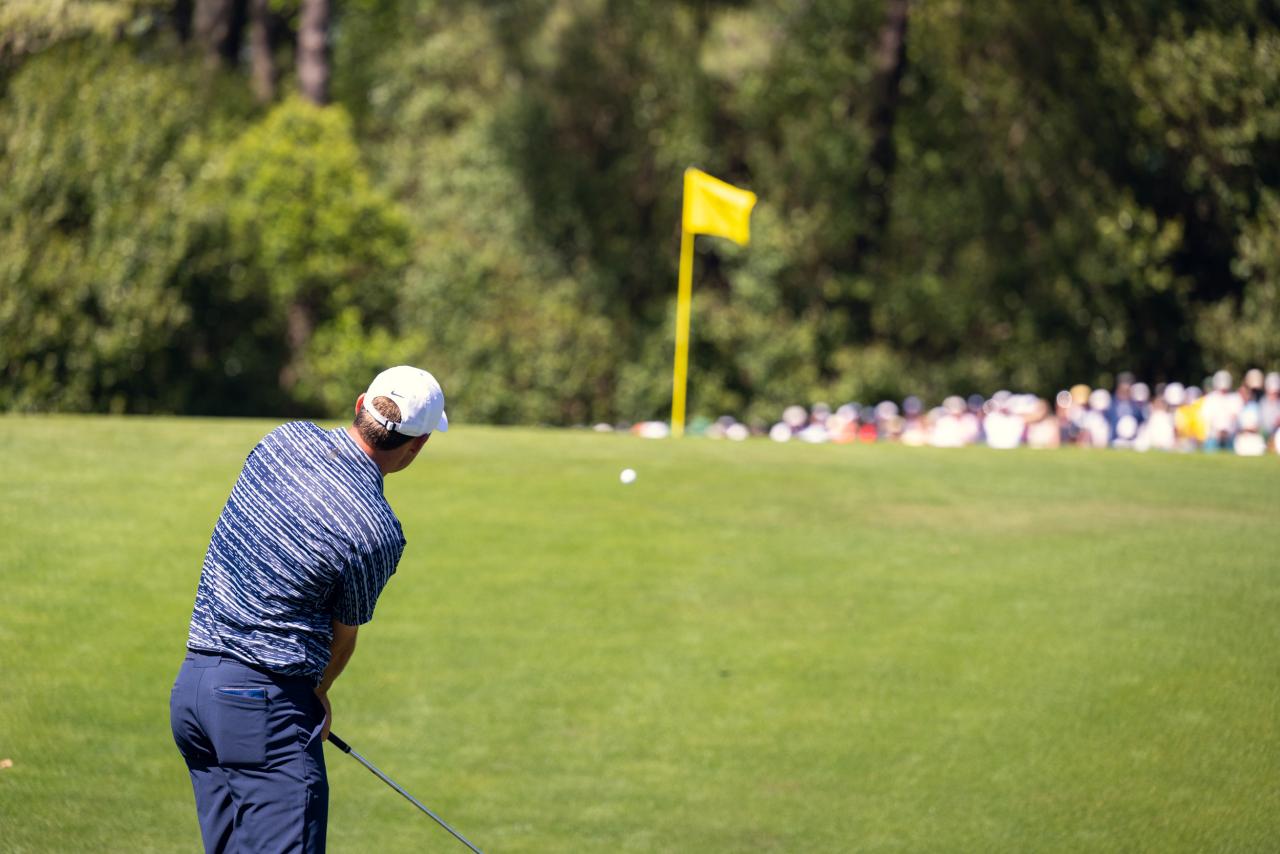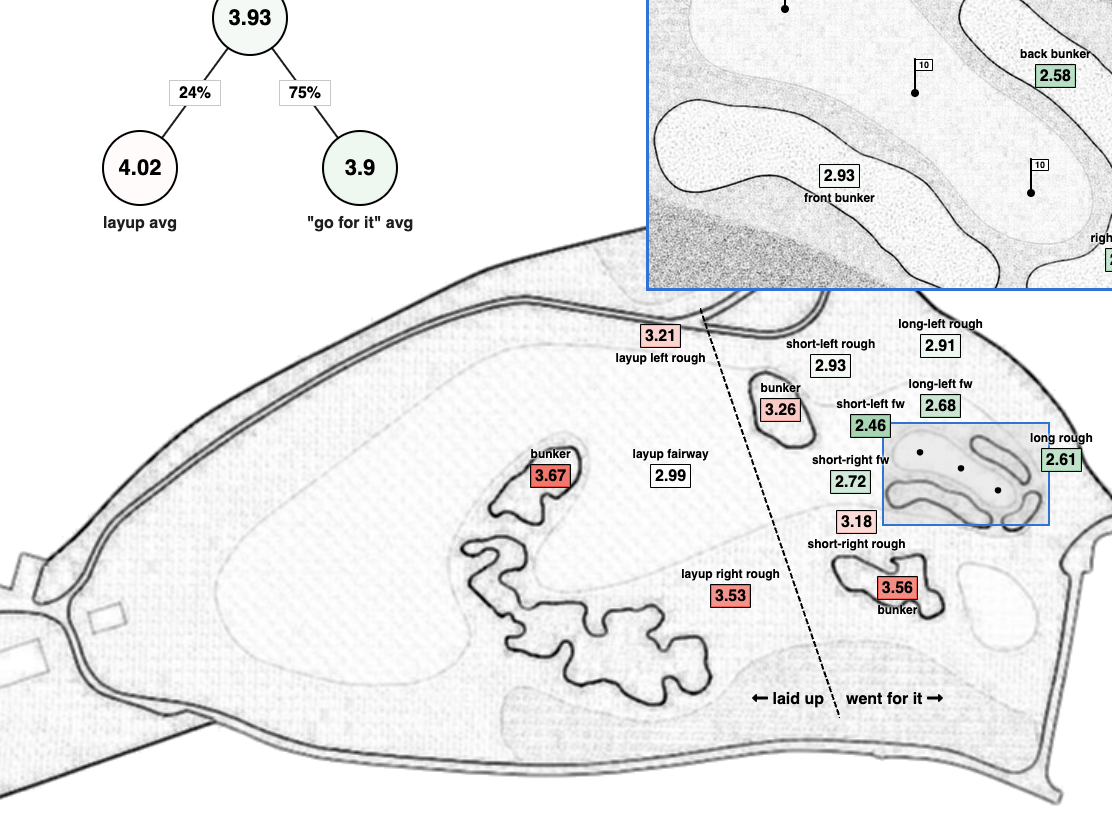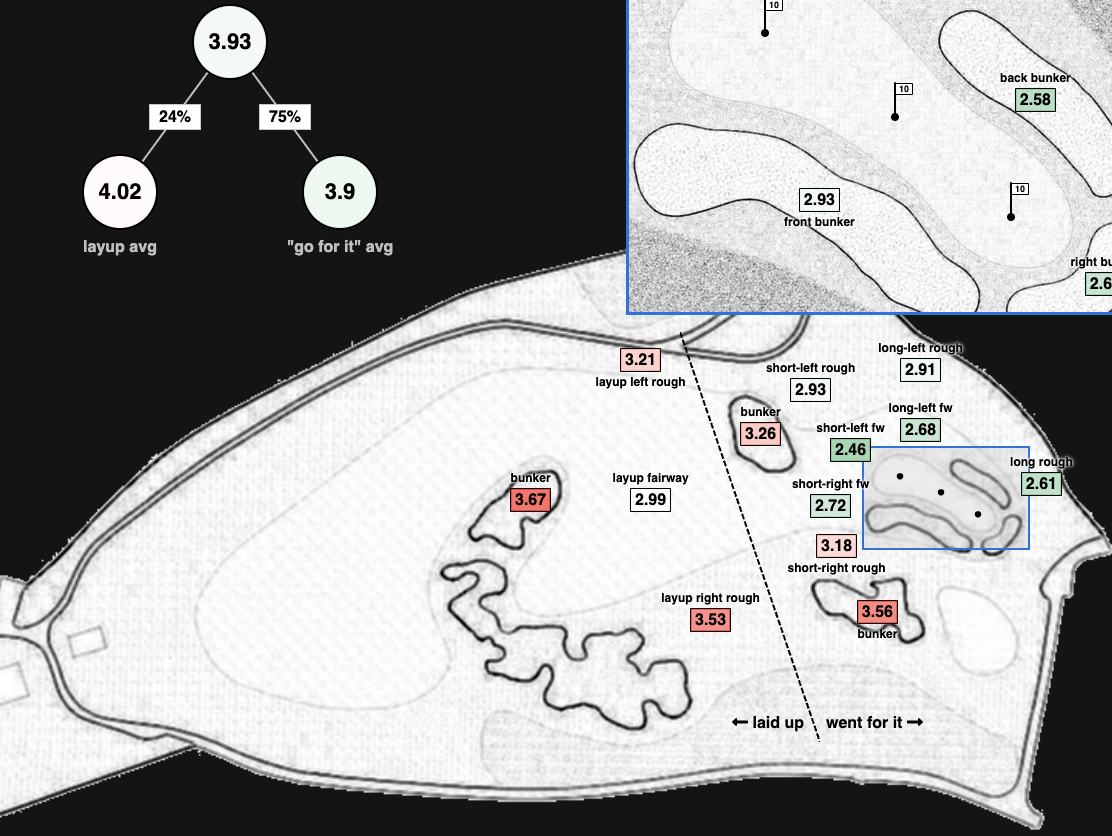
 I.T.N. No. 25
I.T.N. No. 25PUBLISHED March 9, 2021
NIGHT MODE
DAY MODE
Inside The Numbers ...
is a brief numerical summary of the current happenings in the world golf, published every Monday — hopefully.
3.7% WIN PROBABILITY
After yet another week in contention at the Arnold Palmer Invitational, Jordan Spieth gave his (already hyped) truthers one more reason to think he’s regained the form that put him at the top of the professional game from 2015 to 2018.
Here at DG we are for the people, so let’s give the people what they want: assume Spieth has solved the issues that have plagued his game in recent years and that his new baseline skill level is determined only by what we’ve seen so far in 2021. Doing this gives him a baseline skill of 2.3 strokes better than an average PGA TOUR player per round, which is actually similar to the heights he reached, and sustained, in his "prime".
Using this new baseline skill level, but still applying our TPC Sawgrass course fit and history adjustments, Spieth’s new predicted skill for The Players Championship is +1.86. Running a new tournament simulation using our custom simulator, Spieth's win probability shoots up from 0.3% to 3.7%, behind only Rahm! Here is the top 10 from the Spieth-adjusted simulation:
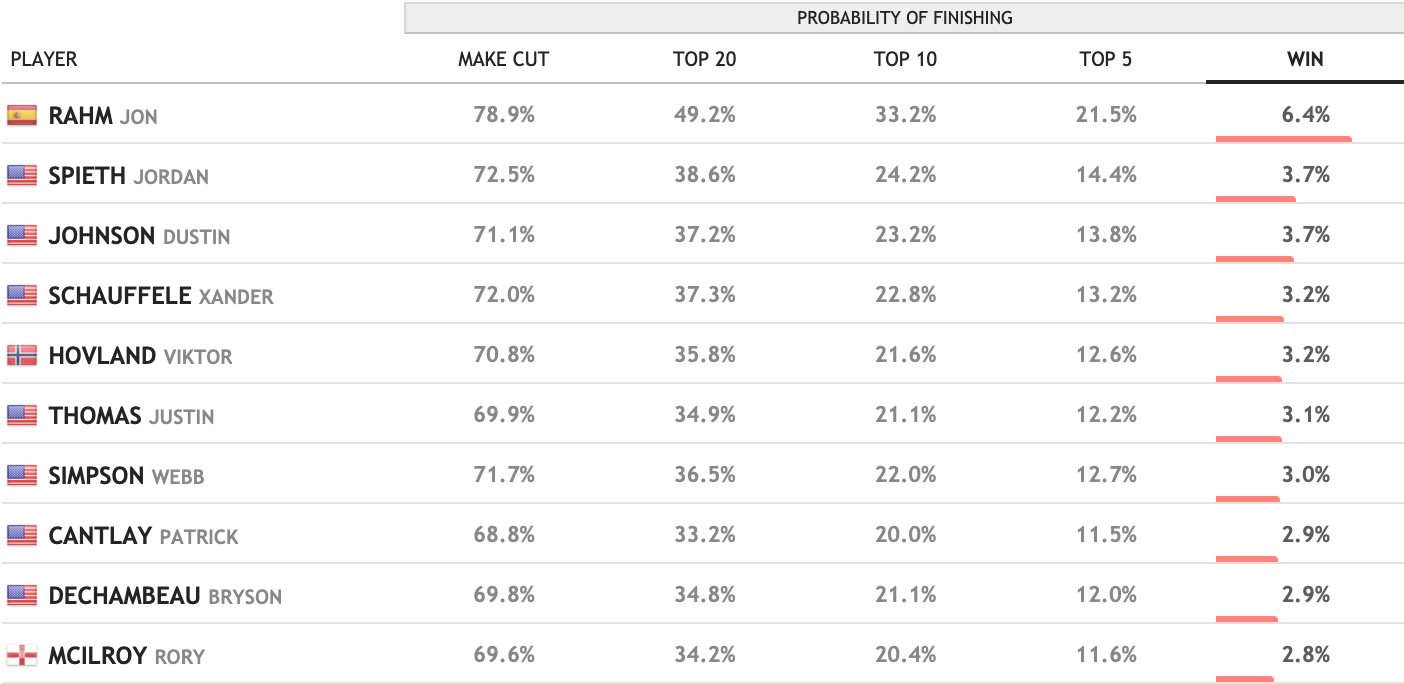
 Interestingly, this is not too far from
where betting markets
have landed on Spieth.
Interestingly, this is not too far from
where betting markets
have landed on Spieth.
Here at DG we are for the people, so let’s give the people what they want: assume Spieth has solved the issues that have plagued his game in recent years and that his new baseline skill level is determined only by what we’ve seen so far in 2021. Doing this gives him a baseline skill of 2.3 strokes better than an average PGA TOUR player per round, which is actually similar to the heights he reached, and sustained, in his "prime".
Using this new baseline skill level, but still applying our TPC Sawgrass course fit and history adjustments, Spieth’s new predicted skill for The Players Championship is +1.86. Running a new tournament simulation using our custom simulator, Spieth's win probability shoots up from 0.3% to 3.7%, behind only Rahm! Here is the top 10 from the Spieth-adjusted simulation:


-0.41 STROKE ADJUSTMENT
Fresh off winning Arnie’s tournament and almost driving the par 5 sixth hole multiple times at Bay Hill, Bryson DeChambeau’s stock is back on the rise after a relatively slow start to the 2021 season.
Unfortunately for the big lad, TPC Sawgrass is not very welcoming for a player of his skillset. As we’ve written about before, Sawgrass is
unique in that it tends to compress skill differences between players relative to a typical PGA Tour course.
Two of the main drivers of this result are the lack of emphasis that the Ponte Vedra layout places on driving distance, and the above-average premium it places on driving accuracy.
Looking at Bryson’s skill profile (very long, and relatively inaccurate)
it is not surprising that our model is giving him a negative bump in the simulations this week.
In total, we are subtracting 0.41 strokes from his baseline (0.25 for distance; 0.07 for accuracy; 0.09 for short game), putting him behind only Wyndham Clark for the largest negative course fit adjustment this week.
8 HOLES
The finishing holes at TPC Sawgrass are some of the most exciting on the PGA Tour,
and the data actually backs that up. The table below shows the top 15 holes on the
PGA Tour (played a minimum of 1000 times) in terms of their standard deviation in scores:
There are only 8 holes played regularly on the PGA Tour that have more variance than the 17th at Sawgrass, none of which are par 3s. The 18th is ranked 13th on the list, and is one of only two par 4s in the top 15 high-variance holes.
| course | hole | par | std_dev |
|---|---|---|---|
| TPC River Highlands | 13 | 5 | 0.91 |
| Stadium Course | 5 | 5 | 0.90 |
| Sheshan International | 8 | 5 | 0.89 |
| Bay Hill | 6 | 5 | 0.89 |
| Quail Hollow | 7 | 5 | 0.87 |
| Pebble Beach | 18 | 5 | 0.87 |
| TPC Boston | 2 | 5 | 0.83 |
| Golf Club of Houston | 5 | 4 | 0.82 |
| TPC Sawgrass | 17 | 3 | 0.82 |
| Annandale | 5 | 5 | 0.81 |
| El Camaleon | 5 | 5 | 0.81 |
| Augusta National | 15 | 5 | 0.80 |
| TPC Sawgrass | 18 | 4 | 0.80 |
| Augusta National | 13 | 5 | 0.80 |
| Muirfield Village | 15 | 5 | 0.80 |
There are only 8 holes played regularly on the PGA Tour that have more variance than the 17th at Sawgrass, none of which are par 3s. The 18th is ranked 13th on the list, and is one of only two par 4s in the top 15 high-variance holes.
-0.09 STROKE ADJUSTMENT
We are slowly starting to work on incorporating shot-level information into our predictive model.
An easy way to start on that front is by adjusting strokes-gained for hole outs from distances
above some threshold (e.g. 30 yards). The adjustment involves decreasing a golfer's strokes-gained
by 1 shot for every hole out they made in the round.
The idea here is that it's 100% luck whether a golfer
hits it to an inch from the hole versus hitting in the hole, even though the difference
in strokes-gained between the two cases is a full stroke. Therefore when predicting
a golfer's future performance you would not expect any useful information to be
contained in strokes gained due to hole outs. However it occurred to me while
writing this that this is not quite true. While it's entirely luck whether Jordan
Spieth hits it to an inch or in the hole on any given shot, the fact that Spieth
scares the hole more than most golfers means that he has more chances to get lucky
and for the ball to drop in. Therefore there might be some small amount of
information contained
in a golfer's strokes-gained through hole outs, but we are ignoring that when applying
the full stroke penalty.
The interesting thing about this adjustment is that it's almost completely based
on theory. Even with 10 years of data there aren't enough hole outs to accurately
assess their predictive value. However the theory that these shots are basically 100%
luck is strong enough that I don't really need any empirical evidence
to convince me of its validity.
At this week's Players Championship, Jordan Spieth's adjustment of -0.09 strokes is the largest adjustment (in magnitude) being made due to a player's history of hole outs. Spieth holed two shots last week and also two at Pebble Beach a couple weeks earlier. The largest positive adjustment belongs to J.T. Poston at +0.03, who hasn't holed a shot longer than 60 feet since May 24, 2019! The Postman is due.
At this week's Players Championship, Jordan Spieth's adjustment of -0.09 strokes is the largest adjustment (in magnitude) being made due to a player's history of hole outs. Spieth holed two shots last week and also two at Pebble Beach a couple weeks earlier. The largest positive adjustment belongs to J.T. Poston at +0.03, who hasn't holed a shot longer than 60 feet since May 24, 2019! The Postman is due.
0.26 STROKES
The largest course history adjustment we are making this week
is +0.26 strokes and belongs to Adam Scott,
who in his
61-round history
at TPC Sawgrass has performed 0.77 strokes above
expectation (i.e. what we would expect based on his performance at other courses and
his course fit at Sawgrass). Si Woo Kim has an incredible, albeit shorter, history
at TPC Sawgrass: Kim has performed 2.03 strokes above expectation in 17 rounds
here. Our model's adjustment for Kim based off this history is just +0.15.
It's worth thinking a bit more deeply about the differences in these adjustments,
as it's not obvious why one would be higher than the other.
First, suppose that both Scott and Kim actually don't have higher skill levels at TPC Sawgrass; how likely would it be to observe their histories? For Scott, the answer is around 1.6%, and for Kim it's 0.2%. This is interesting because it shows that Kim's history actually provides stronger evidence that he has a different skill level at Sawgrass than Scott's does. However, next suppose that their true skill levels were +0.25 strokes better at Sawgrass; now the probability of observing Scott's history is 7.4% (4.6 times more likely than if his true skill was 0) and for Kim it is 0.5% (2.5 times more likely). The correct way to think about this is that we want to choose the skill adjustment that best explains a player's course history while also respecting the fact that we know players' skill levels don't vary that much across courses. In Si Woo's case, there isn't any reasonably-sized adjustment that is going to explain his history well, which keeps his adjustment (slightly) closer to zero. However in Scott's case, a 0.25 skill adjustment does a much better job of rationalizing his history. Even though 0.25 strokes is a large course-specific skill bump, because it does a much better job explaining the observed data it can be justified.
First, suppose that both Scott and Kim actually don't have higher skill levels at TPC Sawgrass; how likely would it be to observe their histories? For Scott, the answer is around 1.6%, and for Kim it's 0.2%. This is interesting because it shows that Kim's history actually provides stronger evidence that he has a different skill level at Sawgrass than Scott's does. However, next suppose that their true skill levels were +0.25 strokes better at Sawgrass; now the probability of observing Scott's history is 7.4% (4.6 times more likely than if his true skill was 0) and for Kim it is 0.5% (2.5 times more likely). The correct way to think about this is that we want to choose the skill adjustment that best explains a player's course history while also respecting the fact that we know players' skill levels don't vary that much across courses. In Si Woo's case, there isn't any reasonably-sized adjustment that is going to explain his history well, which keeps his adjustment (slightly) closer to zero. However in Scott's case, a 0.25 skill adjustment does a much better job of rationalizing his history. Even though 0.25 strokes is a large course-specific skill bump, because it does a much better job explaining the observed data it can be justified.
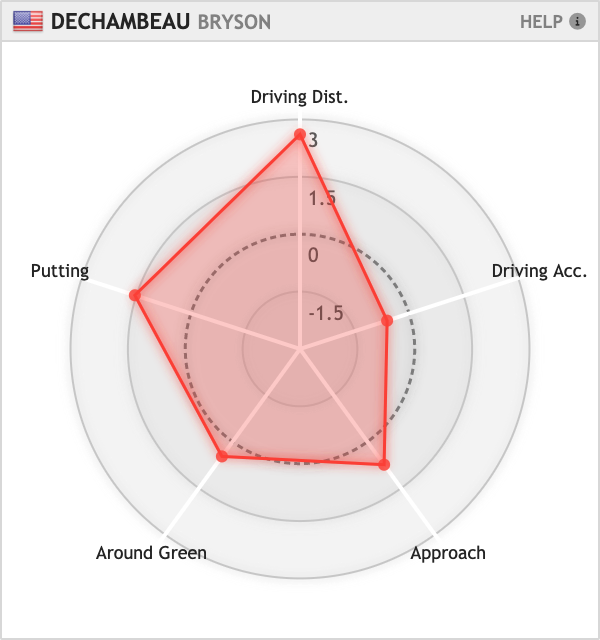


 Major Championship Data Visualizations
Major Championship Data Visualizations
